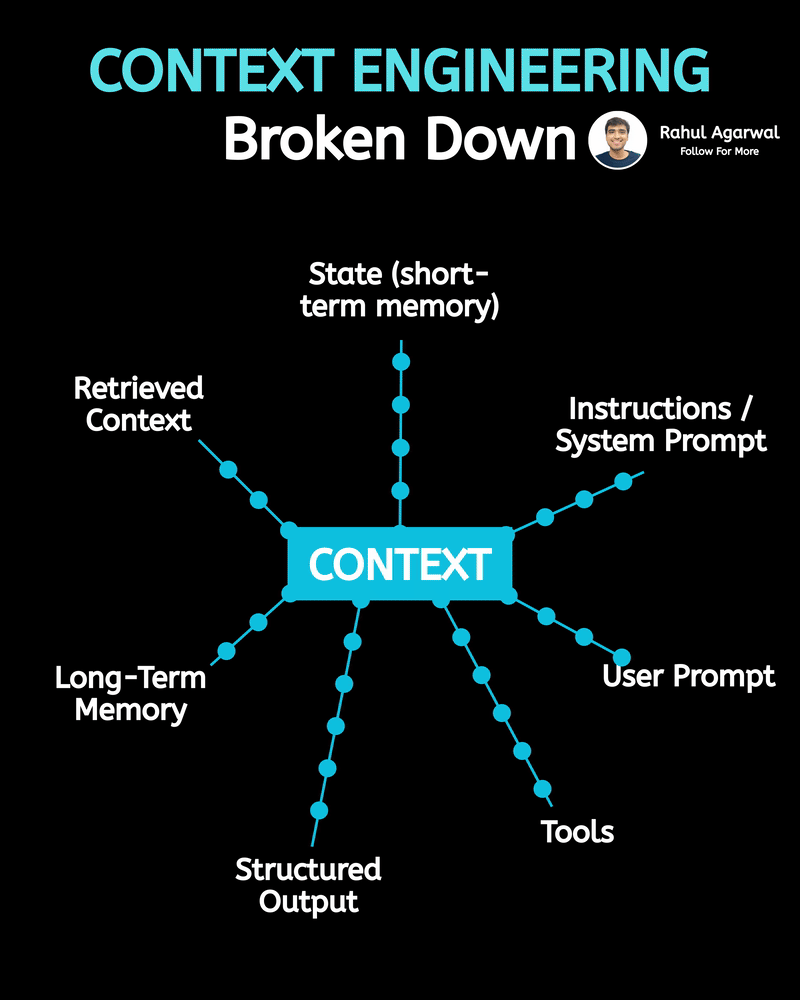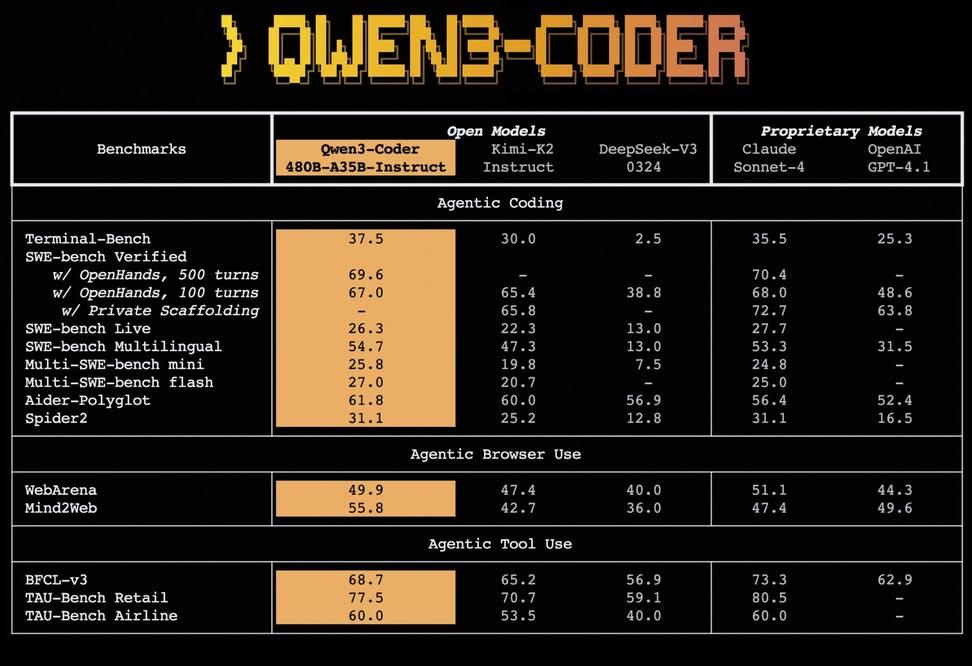Back
Rahul Agarwal
Founder | Agentic AI... • 1m
What exactly is Context Engineering in AI? A quick 2-minute simple breakdown for you. 𝗙𝗶𝗿𝘀𝘁, 𝗵𝗼𝘄 𝗶𝘀 𝗶𝘁 𝗱𝗶𝗳𝗳𝗲𝗿𝗲𝗻𝘁 𝗳𝗿𝗼𝗺 𝗣𝗿𝗼𝗺𝗽𝘁 𝗘𝗻𝗴𝗶𝗻𝗲𝗲𝗿𝗶𝗻𝗴? • 𝗣𝗿𝗼𝗺𝗽𝘁 𝗘𝗻𝗴𝗶𝗻𝗲𝗲𝗿𝗶𝗻𝗴 = crafting a single clever input to guide the model. • 𝗖𝗼𝗻𝘁𝗲𝘅𝘁 𝗘𝗻𝗴𝗶𝗻𝗲𝗲𝗿𝗶𝗻𝗴 = designing the entire environment of information (memory, docs, tools, prompts) so the model always has the right context to work with. These are the steps: 1. 𝗗𝗲𝗰𝗶𝗱𝗲 𝘁𝗵𝗲 𝗴𝗼𝗮𝗹 (𝗯𝗲𝗳𝗼𝗿𝗲 𝗮𝗻𝘆𝘁𝗵𝗶𝗻𝗴) • Ask yourself: 𝘞𝘩𝘢𝘵 𝘥𝘰 𝘐 𝘸𝘢𝘯𝘵 𝘵𝘩𝘦 𝘮𝘰𝘥𝘦𝘭 𝘵𝘰 𝘱𝘳𝘰𝘥𝘶𝘤𝘦? (e.g., a short email, a JSON object, a lesson plan). 2. 𝗜𝗻𝘀𝘁𝗿𝘂𝗰𝘁𝗶𝗼𝗻𝘀 / 𝗦𝘆𝘀𝘁𝗲𝗺 𝗣𝗿𝗼𝗺𝗽𝘁 (𝗿𝗶𝗴𝗵𝘁-𝘁𝗼𝗽) • These are the model’s rules and persona. Think of it as: “You are X, follow Y style and constraints.” 3. 𝗨𝘀𝗲𝗿 𝗣𝗿𝗼𝗺𝗽𝘁 (𝗿𝗶𝗴𝗵𝘁-𝗺𝗶𝗱𝗱𝗹𝗲)• This is the immediate request or question from the user. It tells the model the task. 4. 𝗧𝗼𝗼𝗹𝘀 (𝗿𝗶𝗴𝗵𝘁-𝗯𝗼𝘁𝘁𝗼𝗺)• External helpers the model can call (search, calculator, calendar, API). 5. 𝗦𝘁𝗿𝘂𝗰𝘁𝘂𝗿𝗲𝗱 𝗢𝘂𝘁𝗽𝘂𝘁 (𝗯𝗼𝘁𝘁𝗼𝗺)• A requested format for the result so it’s machine-friendly (JSON, CSV, bullet list). 6. 𝗟𝗼𝗻𝗴-𝗧𝗲𝗿𝗺 𝗠𝗲𝗺𝗼𝗿𝘆 (𝗹𝗲𝗳𝘁-𝗯𝗼𝘁𝘁𝗼𝗺)• Stable facts about the user, company, style preferences, or past interactions you want the model to remember over many sessions. 7. 𝗥𝗲𝘁𝗿𝗶𝗲𝘃𝗲𝗱 𝗖𝗼𝗻𝘁𝗲𝘅𝘁 (𝗹𝗲𝗳𝘁-𝗺𝗶𝗱𝗱𝗹𝗲)• Documents or snippets pulled in just for this query (knowledge base, product docs, previous chat lines). 8. 𝗦𝘁𝗮𝘁𝗲 (𝘀𝗵𝗼𝗿𝘁-𝘁𝗲𝗿𝗺 𝗺𝗲𝗺𝗼𝗿𝘆) (𝘁𝗼𝗽)• What’s happening 𝘳𝘪𝘨𝘩𝘵 𝘯𝘰𝘸 in the conversation — recent messages, variables, or temporary flags. 𝗛𝗼𝘄 𝘁𝗵𝗲𝘀𝗲 𝗽𝗮𝗿𝘁𝘀 𝘄𝗼𝗿𝗸 𝘁𝗼𝗴𝗲𝘁𝗵𝗲𝗿 (𝗳𝗹𝗼𝘄) 1. System prompt sets the rules first (how the model should behave). 2. Long-term memory and retrieved context provide background facts the model should use. 3. State supplies immediate conversation history and live variables. 4. User prompt gives the specific task. 5. The model can call Tools if it needs real-time info or actions. 6. The model returns the answer, ideally in the Structured Output format you asked for. ✅ Repost for others who want to understand Context Engineering.

More like this
Recommendations from Medial
AMBIT VITIN
Helping founders fix... • 3m
Most of us rely on prompting to get the work done through ChatGPT. Even I used to follow this technique until one of my friends taught me how to master Context Engineering. Here's how it works: Prompting vs Context Engineering Prompting is about a
See MoreRahul Agarwal
Founder | Agentic AI... • 2d
Hands down the simplest explanation of AI agents using LLMs, memory, and tools. A user sends an input → the system (agent) builds a prompt and may call tools and memory-search (RAG) → agent decides and builds an answer → the answer is returned to th
See More
Muttu Havalagi
🎥-🎵-🏏-⚽ "You'll N... • 1y
Here's a short roadmap for learning CSS: 1. Basic CSS: Start with understanding selectors, properties, and values to style HTML elements. 2. Box Model: Learn how the box model works, including margin, padding, border, and content. 3. Layout: Dive
See MoreDownload the medial app to read full posts, comements and news.



































